AMD Kaveri Review: A8-7600 and A10-7850K Tested
by Ian Cutress & Rahul Garg on January 14, 2014 8:00 AM ESTIntegrated GPU Performance: BioShock Infinite
The first benchmark in our test is Bioshock Infinite, Zero Punctuation’s Game of the Year for 2013. Bioshock Infinite uses the Unreal Engine 3, and is designed to scale with both cores and graphical prowess. We test the benchmark using the Adrenaline benchmark tool and their three default settings of Performance (1280x1024, Low), Quality (1680x1050, Medium/High) and Xtreme (1920x1080, Maximum) noting down the average frame rates and the minimum frame rates.
Bioshock Infinite, Performance Settings
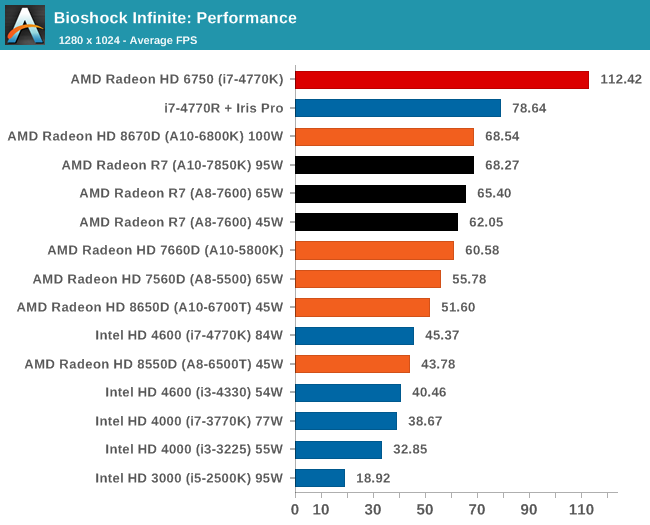
For BI: Performance we see the Iris Pro being top of the IGPs, although the next six in the list are all AMD. The Kaveri cores are all between the 6800K and 5800K for this test, and all comfortably above 60 FPS average.
Bioshock Infinite, Quality Settings

For the quality settings, the Iris Pro starts to struggle and all the R7 based Kaveri APUs jump ahead of the A10-6800K - the top two over the Iris Pro as well.
Bioshock Infinite, Xtreme Settings
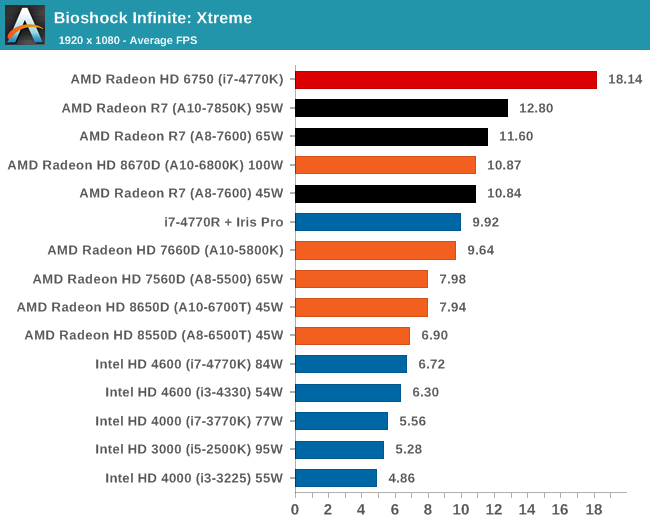
The bigger the resolution, the more the Iris Pro suffers, and Kaveri takes three out of the top four IGP results.
Integrated GPU Performance: Tomb Raider
The second benchmark in our test is Tomb Raider. Tomb Raider is an AMD optimized game, lauded for its use of TressFX creating dynamic hair to increase the immersion in game. Tomb Raider uses a modified version of the Crystal Engine, and enjoys raw horsepower. We test the benchmark using the Adrenaline benchmark tool and their three default settings of Performance (1280x1024, Low), Quality (1680x1050, Medium/High) and Xtreme (1920x1080, Maximum) noting down the average frame rates and the minimum frame rates.
Tomb Raider, Performance Settings
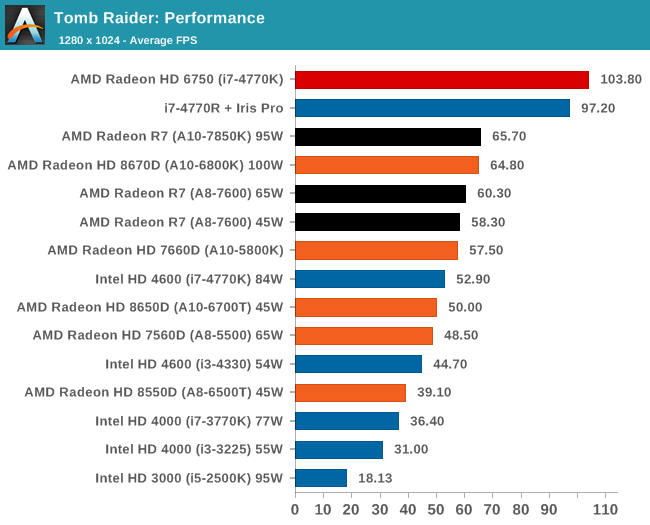
The top IGP for Richland and Kaveri are trading blows in TR.
Tomb Raider, Quality Settings

The Iris Pro takes a small lead, while the Kaveri 95W APU show little improvement over Richland. The 45W APU however is pushing ahead.
Tomb Raider, Xtreme Settings
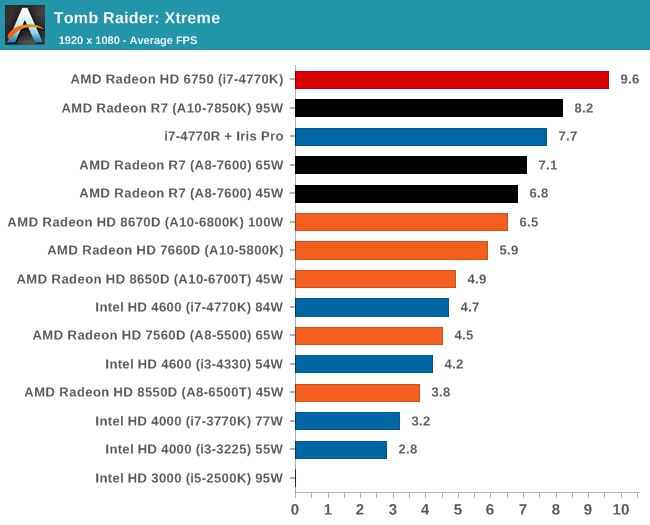
At the maximum resolution, the top Kaveri overtakes Iris Pro, and the 45W Kaveri it still a good margin ahead of the A10-6700T.
Integrated GPU Performance: F1 2013
Next up is F1 2013 by Codemasters. I am a big Formula 1 fan in my spare time, and nothing makes me happier than carving up the field in a Caterham, waving to the Red Bulls as I drive by (because I play on easy and take shortcuts). F1 2013 uses the EGO Engine, and like other Codemasters games ends up being very playable on old hardware quite easily. In order to beef up the benchmark a bit, we devised the following scenario for the benchmark mode: one lap of Spa-Francorchamps in the heavy wet, the benchmark follows Jenson Button in the McLaren who starts on the grid in 22nd place, with the field made up of 11 Williams cars, 5 Marussia and 5 Caterham in that order. This puts emphasis on the CPU to handle the AI in the wet, and allows for a good amount of overtaking during the automated benchmark. We test at three different levels again: 1280x1024 on Low, 1680x1050 on Medium and 1920x1080 on Ultra. Unfortunately due to various circumstances we do not have Iris Pro data for F1 2013.
F1 2013, Performance Settings
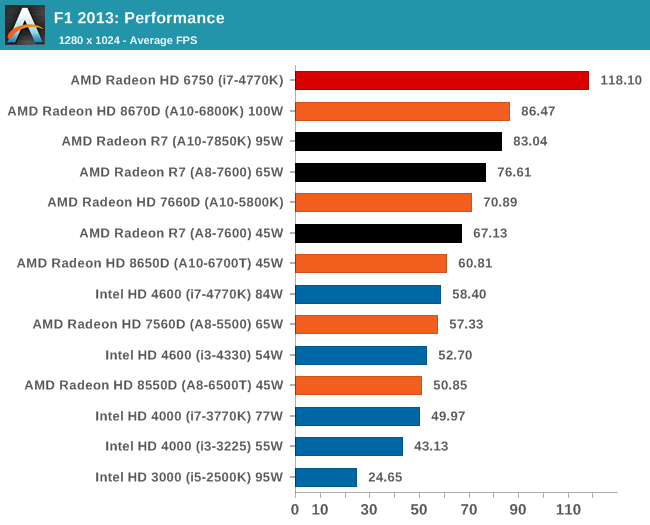
F1 likes AMD here, although moving from Kaveri to Richland at the high end seems a bit of a regression.
F1 2013, Quality Settings
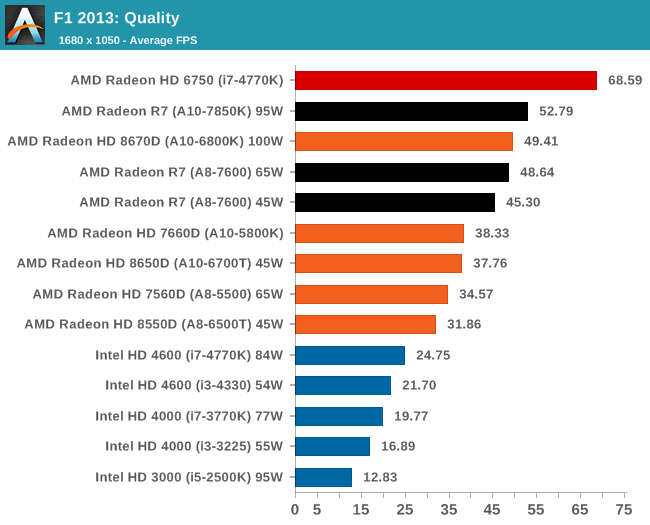
Similarly in the Quality settings, none of the Intel integrated graphics solutions can keep up with AMD, especially Kaveri.
F1 2013, Xtreme Settings

On extreme settings, at 1080p, the top Kaveri APU manages to hit over 30 FPS average during the benchmark. The other A8 Kaveri data is not too far behind.










380 Comments
View All Comments
takeship - Tuesday, January 14, 2014 - link
Also, any chance that power consumption numbers are going to be added to this review? Looking around the rest of the internet, it would appear than AMD's idea of 45W/65W don't really jive with the actual consumption figures. I.e. their 45W chip is actually pulling closer to 80W under load, and doesn't make them even perf/watt comparable with an i3.silverblue - Tuesday, January 14, 2014 - link
I saw similar figures, but that was for the system as a whole.Traciatim - Wednesday, January 15, 2014 - link
Keep in mind that measuring 80 watts from the wall through an 80% efficient supply has the whole machine consuming 64 watts.aryonoco - Tuesday, January 14, 2014 - link
"...do any AnandTech readers have an interest in an even higher end APU with substantially more graphics horsepower?"Definitely yes, for a low-end steam machine for casual gaming in the living room.
The only way to hit the $400 price for a steam machine is to forgo the dedicated graphics card and use an APU/SoC. But none of these Kaveri SKUs, even the highest end A10 one, would cut it. I do not expect such an APU to beat $200 dedicated cards, but it needs more performance than this.
If AMD could offer a Kaveri APU with say 30% more GPU power and the same CPU power, for around $200, I think it would be a very attractive option for a steam machine.
Of course that would require AMD to finally start making respectable Linux drivers as well... which probably means it won't happen.
Nagorak - Wednesday, January 15, 2014 - link
I'd wait and see if the Steam OS even goes anywhere. Odds are strongly against it.nemesis1985 - Tuesday, January 14, 2014 - link
1680x1050A10-7850 = company of heroes --- sleeping dogs --- f1 2013
fps ====== 35 ======= 21 ====== 38 =
A10-7600 = company of heroes --- sleeping dogs --- f1 2013
fps ====== 61 ======= 52 ====== 42 =
1920x1080 = same (problem)
and says kaveri have only 2 cores
or its just a misunderstanding by me
http://images.anandtech.com/doci/7677/G2%20-%20100...
http://images.anandtech.com/doci/7677/G9%20-%2045W...
whats wrong with this bench
nemesis1985 - Tuesday, January 14, 2014 - link
beomagi -Nevermind - I now see this is as a percent difference compared to the slower chip - the title said FPS and that threw me off.
Ignore! :D
yeah me too :D
nemesis1985 - Tuesday, January 14, 2014 - link
misunderstanding (very sorry) please delete my commentkwrzesien - Tuesday, January 14, 2014 - link
Pretty disappointing.And what's the point of testing 1080p gaming at top settings? Does it even matter who is better when below 15 fps? Why not find a setting for each game in 1080p where at least one solution is over 30 fps average - that might show something interesting.
mavromanitari - Tuesday, January 14, 2014 - link
Anandtech Logic:Let's match up a 170$ amd APU vs the intel IGP flagship (4770R) that costs 392$...
Nah still beats it at high resolutions, we need to do more! Oh well lets put the 320$ 4770K and throw 100$ on a dGPU...
We have done it!! Yay the 420$ combination beats the 170$ APU....